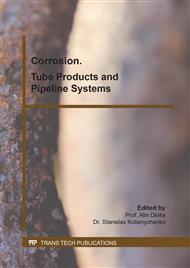p.1235
p.1242
p.1251
p.1257
p.1265
p.1270
p.1277
p.1286
p.1293
Failure Analysis and Solution to Bimetallic Lined Pipe
Abstract:
Owing to low cost, excellent pressure and corrosion resistance, bimetallic lined pipes were regarded as one of the most important methods to resolve corrosion of traditional steel pipes used for oilfield. Nowadays, the pipes are widely used in the projects of oil and gas gathering and transportation. However, there were some failure cases in succession in recent years. In this paper, the failure causes were excavated from multiple perspectives, and on this basis further countermeasures were put forward. Firstly, three typical failure accidents, including CRA layer collapse, CRA layer corrosion and weld joint failure, were listed throughout the whole life cycle from product ordering, construction technology to later operation. Secondly, failure analysis was carried out from five aspects: product quality, test technology, welding process, standard specification and application threshold, and a serial of comprehensive views were proposed. 1) Manufacturing period: Water seepage and tightness between CRA layer and backing pipe could not be effectively monitored. The ratio of collapse test was low so that proposed relevant risk could not be eliminated; 2) Welding period: the process has high risk failure in theory and lack of process assessment and construction acceptance standards. Potential danger could not be effectively assessed, and weld quality could not be guaranteed; 3) Application period: The CRA application range remained unclear, and bimetallic lined pipes were used in the environment beyond the threshold sometimes. The paper also summarized further improvement measures and research directions about these five aspects, including process quality, inspect technique, welding process, standard specification and application range. Finally, solution suggestions were proposed for the whole chain from manufacturers, testing institutions, construction units to oilfield users.
Info:
Periodical:
Pages:
1265-1269
Citation:
Online since:
May 2020
Authors:
Price:
Сopyright:
© 2020 Trans Tech Publications Ltd. All Rights Reserved
Share:
Citation:



